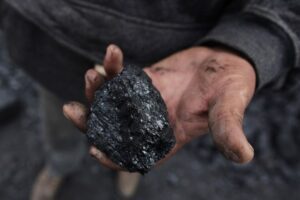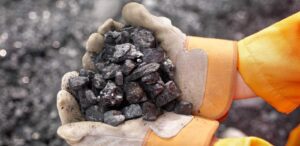
Ukraine needs to import approximately 3.5 million tonnes of thermal coal during the coming heating season, Energy Minister Herman Haluschenko has said.
“Additionally, it is needed to import about 3.5 million tonnes during the heating season in accordance with the coal accumulation schedule,” the minister said in an exclusive interview with Interfax-Ukraine.
At the same time, he noted that generating companies – both DTEK and Centrenergo – have begun to conclude contracts for coal imports.
According him, the price of electricity in the market already makes it possible “to calmly buy coal, produce [electricity], sell and earn money.”
“We expect that we will stabilize the situation with coal and will calmly pass the autumn-winter period,” the minister said.
At the same time, he noted that in the heating season of this year, the Ministry of Energy also expects “certain achievements” – the NPP operation with at least 14 units out of 15 operating, as well as, if necessary, especially in December-January, connection of the 15th atomic block to the system. According to his forecasts, gas reserves in underground storage facilities will reach 19.5 billion cubic meters at the beginning of the autumn-winter period.
According to presidential decree 452/2021, promulgated on Monday, which approved the decision of the National Security and Defense Council (NSDC) dated July 30, 2021 on measures to neutralize threats in the energy sector, the Cabinet of Ministers must ensure the accumulation of natural gas, reserve fuels and coal by October 31 of this year for the smooth operation of the fuel and energy complex during the heating period 2021/2022, as well as the priority of providing open wagons for shipment of coal products by rail in accordance with the requests of coal enterprises – mines and processing plants. Also, the government needs to ensure the completion of the implementation of measures regarding the readiness of the fuel and energy complex to work in a special period and make appropriate decisions.

DTEK Energy, amid low coal stocks at its TPPs’ warehouses, has begun importing thermal coal from Kazakhstan and is negotiating coal supplies from Poland and the United States, the company’s press service has said.
According to the press service, DTEK Energy is actively looking for opportunities to provide TPPs with additional imported coal.
“Despite the increased demand for coal on global markets, we are actually starting to import it. The first batch from Kazakhstan is already on its way. Next week we expect the start of coal supplies from Poland. We are also negotiating the supply of shiploads from the United States,” CEO of DTEK Energy Ildar Saleev said.
According to the Ministry of Energy of Ukraine, coal stocks in the warehouses of thermal power plants of five power generating companies (DTEK Dniproenergo, DTEK Zakhidenergo, DTEK Skhidenergo, Centrenergo and Donbasenergo) as of Wednesday morning dropped to 754,000 tonnes, which is almost 500,000 tonnes less than the accumulation schedule approved by the ministry on August 11 (1.237 million tonnes).

Ukraine in January-June 2021 increased imports of coal and anthracite by 17.6% compared to the same period in 2020, to 10.145 million tonnes.
According to the State Customs Service, coal was imported for $984.046 million, which is 4.1% more than in January-June 2020 ($945.346 million).
Coal came from the Russian Federation for $587.543 million (a share in imports – 59.71%), the United States – for $221.273 million (22.49%), Kazakhstan – for $114.96 million (11.68%), other countries – for $60.27 million (6.12%).
Coal exports by Ukraine for the six months of 2021 amounted to 204 tonnes for $25,000, in particular to Hungary – for $11,000, Belarus – for $7,000, Bulgaria – for $7,000. In the same period last year, no export was carried out.

Corum Group (DTEK) has signed the first contract with Turkey’s leading coal mining company Imbat Madencilik for a pilot supply of KD90T 17.5/28 support sections, Corum said in a press release on Friday.
According to the statement, entering new markets is one of the key directions of the company, approved as part of the adopted development strategy until 2030, among which the goals are to arrange the supply of mining equipment to the markets of Turkey and India.
“Due to the mining and geological features, coal mining in Turkey is associated with other dangerous and complex challenges compared to Ukraine. Therefore, in the foreground are occupational safety and modern technological solutions, which is the focus of Corum Group equipment,” the press service said, citing Director of Corum Trading Oleh Nesterenko.
The supports are optimized for the client’s conditions, they will be manufactured by Corum Druzhkivka Machine Plant (Donetsk region), and the shipment is scheduled for this summer.
“Corum experts paid a lot of attention to the issues that arise with our current fleet of powered roof supports from Poland and China, and suggested solutions to the problems. Therefore, we decided to try and test Corum products,” General Manager of Imbat Madencilik Yavuz Burbut said.
The cost of the deal was not disclosed.
Corum Group is a leading manufacturer of mining equipment in Ukraine, unites machine-building assets of DTEK Energy.

Coke and chemical plants of Ukraine in January-May of this year imported 4 million tonnes of raw coking coal and coking coal concentrate, which is 4.2% more than in the same period last year.
According to an information note of the Ukrmetalurgprom association, the supply of Ukrainian coal mined during this period amounted to 1.64 million tonnes, which is 8.6% more than in the same period last year.
In general, in January-May 2021, Ukrainian coke and chemical plants received 5.64 million tonnes of coal for coking, which is 5.4% more compared to January-May 2020. At the same time, the share of imported coal in the total supply amounted to 70.9% versus 71.8% in January-May 2020.
Some 3.424 million tonnes of coke (101.8% compared to January-May 2020) were supplied to Ukrainian metallurgical enterprises, including 3.346 million tonnes of Ukrainian origin (100.3%), and 68,000 tonnes of imported (4.53 times more). The share of imported coke in the total supply amounted to 1.99% versus 0.45% in January-May last year.
In addition, in January-May 2021, some 1.5 million tonnes of scrap metal were procured (134.8% compared to the same period in 2020), of which 1.354 million tonnes (123.5%) were supplied to Ukrainian consumers as imported. Exports of scrap metal in January-May 2021 amounted to 146,000 tonnes (887%).
It is noted that the provision of metallurgical enterprises with Ukrainian iron ore raw materials for the specified period was carried out in accordance with the needs of metallurgical production. The iron ore was not imported. Iron ore exports in January-May 2021 amounted to 18.54 million tonnes (98.2% compared to the same period in 2020).
According to the updated data of Ukrmetalurgprom, in January-May of this year, 14.029 million tonnes of sinter were produced (107.8% versus January-May 2020), 4.107 million tonnes of gross coke with moisture content 6% (102.2%), some 8.903 million tonnes of cast iron (109.1%), some 8.987 million tonnes of steel (108.3%), some 8.023 million tonnes of rolled products (108%), and 390,000 tonnes of pipe products (115.8%).
As of June 10, 2021, of the main operating production facilities 18 out of 21 blast furnaces, seven out of eight open-hearth furnaces, 14 out of 16 converters, five out of 15 electric furnaces and 16 out of 17 continuous casting machines were in operation.

International consulting company Environmental Resources Management (ERM, the United Kingdom) will provide assistance to the Energy Ministry in the implementation of the program for the transformation of coal regions, the Energy Ministry said on its website on late Thursday. According to the report, ERM, which specializes in drafting sustainable development projects, presented a draft plan for a pilot project for the transformation of coal regions on May 13.
It is noted that in preparation for the project, British and Ukrainian specialists must determine the coal region where the pilot project will be implemented, conduct preliminary consultations with stakeholders and develop a transformation plan directly by late March 2022.
The program, which provides for drafting a project for a fair transformation of one of the coal regions of Ukraine, is funded by the British government, the Energy Ministry said.
As reported, in March this year, the Canadian mining company Black Iron, which is implementing a project to create a new iron ore project in Kryvy Rih (Dnipropetrovsk region), announced the involvement of Environmental Resources Management to conduct an environmental and social impact assessment (ESIA).
ERM was selected to lead this ESIA based on their highly regarded global reputation of expertise in this field that includes several successful projects also conducted in Ukraine.
ERM has over 140 offices globally with headquarter in London.
In the second half of March, the Energy Ministry, headed at that time by Yuriy Vitrenko, withdrew for revision the concept of reforming the coal industry, which envisages, in particular, the merger of promising mines with PJSC Centrenergo and subsequent privatization and liquidation of unprofitable enterprises.